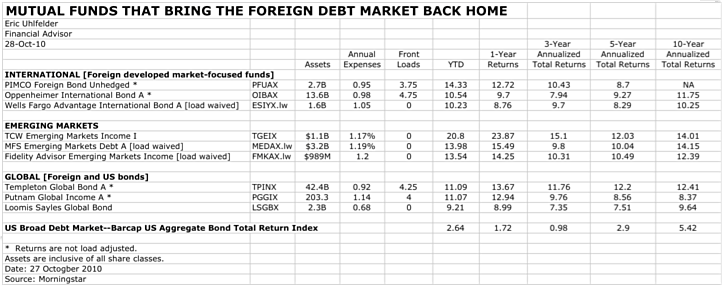Foreign Bond Investing: The Search for Yield
3 November 2010, Financial Advisor
Yields on investment-grade domestic bonds have been nonexistant for a while. Bondholders have been profiting only because already low interest rates have been pushed even lower through government policy and investors scrambling for safe havens, which have sent prices higher.
Venerable fixed-income manager Bill Gross, who runs the largest bond fund at Pacific Investment Management Co., now believes renewal of asset purchases by the Federal Reserve, a.k.a. quantitative easing, will likely signify the end of this rally. With real rates essentially negative, there isn’t much more room for them to fall any way.
This suggests advisors should be looking beyond our shores for fixed-income opportunities. The reasons: higher interest rates, improving foreign credits, compressing spreads over US Treasuries and rising prices, and the renewed downward trend of the US dollar are all boosting total returns from foreign bonds.
Index performance shows the benefits of international diversification. The Barclays Aggregate Bond Fund Index, which tracks US investment-grade bonds, rose 7.84% over the past year through September and 5.99% annually over the last 5 years. Over the two same time periods, Morningstar reports the average return of World Bond funds is 8.24 and 6.59%, respectively.
Global Opportunities
Basic global bond investing strategy is based on the principle that markets tend to be at different stages in the economic cycle. For instance, when the US is slowing down and cutting interest rates, Europe or Asia might be recovering and pushing rates up to contain potential inflation, offering greater yield. Moreover, investing in economies where rates are moving higher could further enhance returns when foreign currencies are translated back into dollar.
But the financial crisis and subsequent collapse of interest rates across the developed markets has broken this pattern, leaving no obvious place in which global fixed-income investors should be. Accordingly, it has fed the flow of assets into emerging market bonds, which have generated the highest returns of all fixed-income markets. [See tables below.] Morningstar reports that as of the end of October, the average emerging market
bond fund is up 16.01 percent over the last year and 8.84 percent annually over the last five years.
However, it wasn’t that long ago when massive debt crises moved across emerging markets: first in Mexico in 1994/1995; then in southeast Asia in 1997/1998, followed by Russia in 1998, then across the Pacific to Brazil and Argentina in 2001/2002. In excess of $100 billion was defaulted upon, forcing many investors to take sizable haircuts in restructuring.
Emerging Markets
Fundamental improvements have since occurred in emerging markets, making many safer than they were. “Foremost, these countries have realized capital markets are essential to have on one’s side,” explains Joseph Portera, coportfolio manager of the $444 million Hartford Strategic Income Fund that’s up more than 13% over the past year. “They better understand antagonizing foreign investors through unfavorable refinancing or currency devaluation is not in their best interests.” Since the 1990s, many countries have adopted improved fiscal and monetary policies to assuage capital market concerns and enhance their own financials.
Second, most emerging currencies have been delinked from the dollar. Unsustainable local currency correlation with the dollar was a root cause of many emerging market crises. Free floating currencies enable markets to continuously respond to external stresses, avoiding a build up of economic imbalances that in the past required a major shock to relieve pressure.
Third, emerging markets are now less exposed to excessive budgetary and trade imbalances, observes Sara Zervos, coportfolio manager of Oppenheimer’s $13.8 billion International Bond Fund, which has generated 10-year annualized returns of nearly 12%. Strong demand for commodities has generated tremendous trade inflows, enhancing capital reserves. Significant foreign direct investment–acquisitions and joint ventures–has attracted more committed foreign capital.
Fourth, expansion of middle classes across many emerging markets is promoting more stable economies that can better withstand foreign shocks. Daniel Arbess, who manages the $2.1 billion Perella Weinberg Partners Xerion Fund, which has delivered 18% annualized returns since starting up in 2003, believes this is a key driver that is shifting global growth from the west to the east.
Net inflows into emerging market debt are on pace set a record this year, potentially topping $70 billion, 40% higher than last year, according to Christopher Dillon, fixed-income portfolio specialist at T. Rowe Price. He believes US and European mutual funds, with an increasing boost from Japan, are pushing this flow.
Two sovereigns representative of emerging market bond opportunities include an “A”- rated Mexican state bond, with a coupon of 8.5 percent. Maturing at the end of 2015, the bond was yielding 7.2% at the end of October, with a yield to maturity of 5.71%. A “Baa3”-rated Brazilian sovereign, due in the beginning of 2015, has a current yield of 10.4% and a yield to maturity of 11.64%. In contrast, the five-year US Treasury bond is yielding 1.69%.
Dillon surmises demand will receive a lift from US pensions. With assets of $16 trillion, and looking to return 8% a year,” says Dillon, “pension managers will likely boost their current negligible allocation to emerging market debt to between 3 and 6% due to the lack of compelling income alternatives.” Expect a similar shift from European and Asian pensions as well.
Developed Markets
Though limited, a few developed markets offer attractive yields. In late October, a “AAA”-rated Australian sovereign, due in April 2015, is currently yielding 6 percent, with a yield to maturity of 5 percent. Investors can gather up to an additional 100 basis points by venturing to Australian state [e.g., Queensland] and corporate bonds.
What makes these bonds especially attractive is exposure to the Australian dollar. Many analysts believe long term the currency should continue to appreciate given the strength of Australian economy, significant commodity wealth and exports to China, and the US dollar’s weak outlook. [See our story on Australia in August 2010 issue.]
While concerns about European debt and the euro sent yields climbing in troubled peripheral markets this past summer, Oppenheimer’s Sara Zervos believes the response of local governments and the European Central Bank has significantly reduced the likelihood of debt restructuring in places like Spain, Italy, Portugal and Ireland. While spreads over Treasuries have come down from the height of the panic, investors can still collect 5 percent on 3-year Irish sovereigns.
If Zervos’s call is correct, attractive yields will be boosted by subsequent credit improvement and bond appreciation. But continued sluggish economic growth could hamper fiscal recovery. According to a recent forecast by the Economist Intelligence Unit, growth across the eurozone over the next several years is projected to be no more than 1.5 percent.
Mutual Funds
Buying individual bonds offers transparency. Investors know the cost, risk, and yield, there are no annual expenses. In case of a selloff, they can wait until maturity to realize full value. And if exchange rates are undesirable when a bond matures, investors can roll over proceeds into another bond denominated and wait until rates improve before repatriating the currency back into dollars.
But most advisors use mutual funds to navigate global debt markets. They offer access to foreign debt through three types of offerings that invest in government, corporate, and supranational [e.g., World Bank] debt. Bonds are issued in local, dollar- and euro-denominated currencies. And issuers can be local firms or multi-nationals looking to finance local operations.
Most international bond funds are focused on developed markets. Emerging market exposure can only be seriously achieved through dedicated funds. And Global funds provide access across developed markets, including the US.
Investors can buy into three types of funds. The largest are open ended [www.etfscreen.com]. This is an evolving group of funds, whose expansion is in response to strong foreign bond performance. They can offer inverse index exposure through shorting.
Key to selecting the right mutual fund is discerning what is driving profitability and how managers are handling risk. Long-term performance is certainly a positive indicator. But it may have been bought with significant volatility that may not sit well with clients, especially since the trick of realizing these managers’ gains is sticking with them during the difficult times.
Caveat
We are in a strange interest rate environment where developed market yields are at historic lows and faith in emerging economies may be exceeding prudence. A diversified portfolio is essential for weathering what is to come. Christopher Diaz, coportfolio manager of the $515 million ING Global Bond Fund, which was up more than 11% annually over the past three years, thinks the recent run of high annual total return is coming to an end; he projects high single-digit returns going forward.
Though it’s not likely to happen soon, Sara Zervos believes there is significant risk if the US starts bumping up interest rates. “Not only would this likely send more assets back to the states, but foreign bond prices—which are based on spreads above US Treasuries—would likely trend lower.”
Developed markets could slip back into recession. If that happens, repairing the most seriously troubled government imbalances may be difficult. This would likely send the cost of borrowing higher and the price of bonds lower.
In emerging markets where economies are healthier, investor demand has pushed the spread of bonds denominated in US dollars over Treasuries below 300 basis point. But until they are hit with their own crises, and we see how they respond, emerging market security remains suspect, regardless of the present euphoria. “When ever you have so much global interest suddenly focused on a relatively small bond market, that gives reason for caution,” warns T. Rowe Price’s Christopher Dillon.



 GIR's Investing in the New Europe
GIR's Investing in the New Europe






